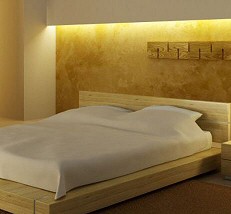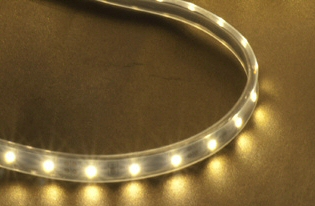
FAQ: What is LED?
What is LED? LED is short for Light Emitting Diode, a solid state electronic device that is capable of emitting light when an electrical current passes through it. See our new NodeSwitch™ Arduino and Vera compatible LED controller.
LED lighting is rapidly replacing conventional lighting methods such as incandescent bulbs, CCFL fluorescent tubes, and halogen lighting because of advances in technology that result in low energy consumption, high brightness, low heat conversion, low lifetime cost, and a compact form factor.
LED lighting was not very popular as a room light alternative at first because the brightness was low, but that is no longer the case. Some of the more advanced LED packages put out over 4,000 lumens (lumen is a unit of light intensity, similar to candlepower) and are actually replacing metal halide projector bulbs in HD projection systems. This is far more light than you need for average lighting conditions.
Color temperature was an issue too. The light that was typically produced by early LEDs was actually a very pure white light which has a cold feel to it, since most of our incandescent light has some yellow in it.
 This is no longer the case and LED lighting is now available in 'warm white', the industry term for color adjusted light that feels more natural. LED light color is referred to as 'color temperature' and is measured in 'degrees Kelvin (K)'. Warm white is in the 2800 - 3200 °K region (area shown inside square on the scale at left).
This is no longer the case and LED lighting is now available in 'warm white', the industry term for color adjusted light that feels more natural. LED light color is referred to as 'color temperature' and is measured in 'degrees Kelvin (K)'. Warm white is in the 2800 - 3200 °K region (area shown inside square on the scale at left).
LED: Flexible Form & Installation for Cove Lighting
 LED lights come in various forms and can be installed in a variety of different ways. For instance, it can be formed into strips that can be cut to size and concealed behind a valance or fascia to produce a warm, distributed, indirect lighting system like the installation above the bed. Because the strips are flexible, they can be formed around curves to make many different shapes of cove lighting.
LED lights come in various forms and can be installed in a variety of different ways. For instance, it can be formed into strips that can be cut to size and concealed behind a valance or fascia to produce a warm, distributed, indirect lighting system like the installation above the bed. Because the strips are flexible, they can be formed around curves to make many different shapes of cove lighting.
The LED light element itself is very small as it does not need to be in a vacuum enclosure, and it generates very little heat. Thus the final size of the housing can be very small too.
You can also have recessed ceiling pot lamps, spotlights, floodlights and all of these lighting types can be indoor or outdoor, and all units can be controlled with dimmers and home automation systems.
There are also direct replacement screw-in bulbs for regular AC household lighting fixtures. They are able to handle a wide range of AC voltages, and 110v or 220v is not a problem.
LED: High Efficiency, Safe Voltage & Long Life
LED lighting typically runs on 12 volts DC, so if you are inclined towards DIY, they are safe to handle for children and adults.
They are an excellent complimentary product to go along with our 12v DC window shade motors. The LED strip lighting can be easily concealed in a typical window blind valance or fascia.
They are very efficient, affordable, use only a relatively small amount of power, and can easily be adapted for off-the-grid solar systems, like our blind motors. They are also perfect for use in RV, motorhomes, campers, boats, etc.
See the LED lighting section in our online store
We sincerely hope you enjoy using these advanced light systems and motors; if you have any questions, please feel free to contact us at any time!

 Shopping Cart Home - Start Here
Shopping Cart Home - Start Here Remote Controls for Radio Equipped Motors
Remote Controls for Radio Equipped Motors DIY Starter Kits for Window Shades
DIY Starter Kits for Window Shades DIY Starter Kits for Window Openers
DIY Starter Kits for Window Openers ZWAVE Blind & Shade Controllers
ZWAVE Blind & Shade Controllers How To Choose the Right Blind & Shade Motor
How To Choose the Right Blind & Shade Motor Select tubular Motor (Comparison table)
Select tubular Motor (Comparison table) Choose RollerTrol Battery & Solar Motors
Choose RollerTrol Battery & Solar Motors DIY Roller Blind Motors - FAQ
DIY Roller Blind Motors - FAQ How To Insert Blind Motors & Attach Brackets
How To Insert Blind Motors & Attach Brackets Calculate your Blind or Shade fabric Weight
Calculate your Blind or Shade fabric Weight Select Tube Size for Blind Motor
Select Tube Size for Blind Motor How to Insert Blind Motors Into Tube
How to Insert Blind Motors Into Tube How to Insert Blind Motors Into Tube with Adapters
How to Insert Blind Motors Into Tube with Adapters Attach Mounting Brackets - Standard + Mini Series
Attach Mounting Brackets - Standard + Mini Series Attach Mounting Brackets - MAXI Blind Series
Attach Mounting Brackets - MAXI Blind Series How To Set Up Radio Equipped Blind & Shade Motors
How To Set Up Radio Equipped Blind & Shade Motors Series P Radio Remote Control Motors
Series P Radio Remote Control Motors Series G Radio Remote Control Motors
Series G Radio Remote Control Motors Series R Radio Remote Control Motors
Series R Radio Remote Control Motors BroadLink RF/IR Hub System for Motors
BroadLink RF/IR Hub System for Motors How To Set Up Window/Skylight Openers
How To Set Up Window/Skylight Openers Introduction: Window & Skylight (K Series)
Introduction: Window & Skylight (K Series) BroadLink RF/IR Hub System for Motors
BroadLink RF/IR Hub System for Motors Z-Wave Interfacing for Shade & Opener Motors
Z-Wave Interfacing for Shade & Opener Motors Wired Wall Switch Control of Window Openers
Wired Wall Switch Control of Window Openers How To Use Alexa With Our Motors & Window Openers
How To Use Alexa With Our Motors & Window Openers How To Use BroadLink Phone App Hub With Our Motors
How To Use BroadLink Phone App Hub With Our Motors How To Set Up ShadeSlider Skylight or Bottom-Up Blind
How To Set Up ShadeSlider Skylight or Bottom-Up Blind How To Retrofit RV, Boat and Motorhome Blinds
How To Retrofit RV, Boat and Motorhome Blinds How To Set Up Non-Radio Motors
How To Set Up Non-Radio Motors Operation & Travel Limits of Non-Radio Motors
Operation & Travel Limits of Non-Radio Motors Make a Simple DC Motor Reversing Switch
Make a Simple DC Motor Reversing Switch How To Set Up ZWAVE Control
How To Set Up ZWAVE Control ZWAVE Controller for G Series Radio motors
ZWAVE Controller for G Series Radio motors ZWAVE Door/Window Opening Detection
ZWAVE Door/Window Opening Detection ZWAVE Motion Detector with Temperature Sensing
ZWAVE Motion Detector with Temperature Sensing Motorized Window Blinds & Shades
Motorized Window Blinds & Shades Motorized Dual Window Shade
Motorized Dual Window Shade Make Motorized Blackout Blinds
Make Motorized Blackout Blinds Phone-Tablet-PC Control for Motorized Blinds
Phone-Tablet-PC Control for Motorized Blinds Mini Motor for Existing Shade Retrofit
Mini Motor for Existing Shade Retrofit Roman Shade Retrofit
Roman Shade Retrofit Make a Motorized Window Opener
Make a Motorized Window Opener Blind & Shade Motors for RV & Boats
Blind & Shade Motors for RV & Boats Make Your Own Projector Screen
Make Your Own Projector Screen Curtain Closer: Ultimate Home Theater
Curtain Closer: Ultimate Home Theater Wireless Battery Operated Drapery Motor Kit
Wireless Battery Operated Drapery Motor Kit Make a Motorized Bottom-Up Shade
Make a Motorized Bottom-Up Shade Make a Motorized Skylight Opener
Make a Motorized Skylight Opener BroadLink RF/IR Hub System for Motors
BroadLink RF/IR Hub System for Motors Why Buy From US?
Why Buy From US? Background & Mission Statement
Background & Mission Statement Customer DIY Testimonials
Customer DIY Testimonials Site Map - Search All Pages
Site Map - Search All Pages Why Buy From US?
Why Buy From US? RollerTrol Users Forum
RollerTrol Users Forum Contact Page
Contact Page